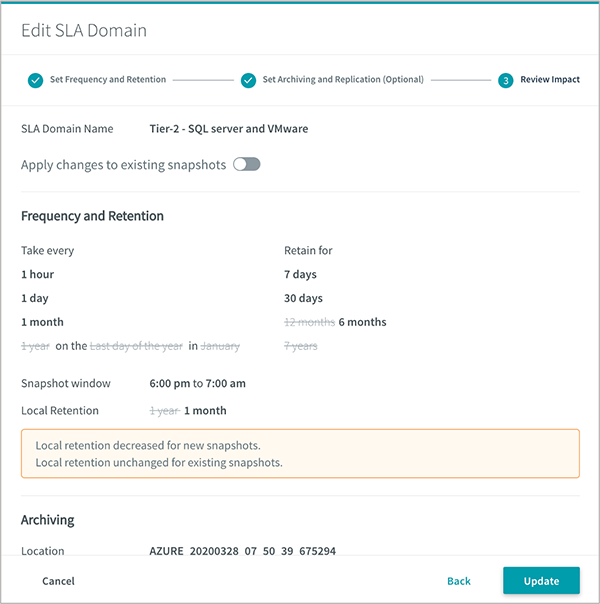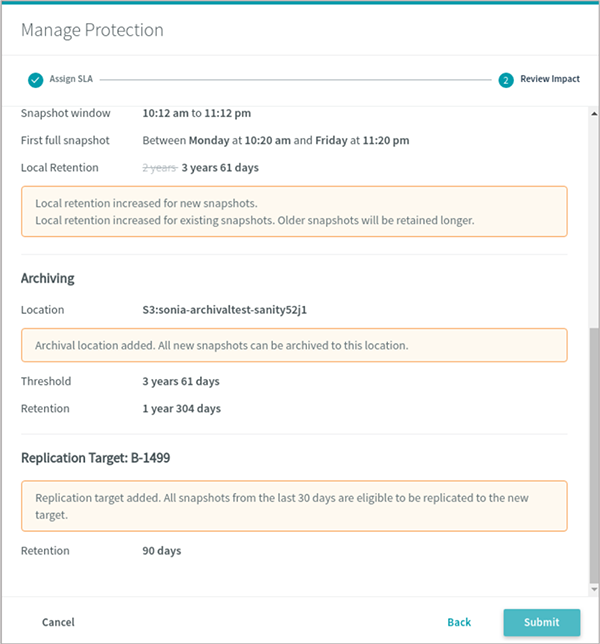With Rubrik Andes 5.2, we are thrilled to announce two substantive advancements to SLA Domains that ensure IT and compliance are in harmony throughout the data lifecycle: flexible data retention and legal hold. SLA Domains are the fundamental building block of the Rubrik Cloud Data Management platform and empower customers to automate the entire data lifecycle, including backup, replication, archival, and continuous data protection.
Flexible Data Retention
Backup administrators typically use pre-defined SLA retention policies for different object types that may vary depending on the workload and if the objects need to be archived or replicated. Oftentimes, admins need to change the retention policies of certain object types to meet new requirements from different lines of business, optimize storage consumption of servers that are decommissioned, or discontinue archival and replication of certain objects. When speaking with our customers, many stressed the importance of being able to change retention policies without impacting the retention of existing snapshots. To address these needs, Rubrik Andes 5.2 provides the flexibility to avoid applying changes to existing snapshots anytime an SLA is edited or re-assigned.
Here’s a rundown of how flexible data retention works:


The calendar view across all objects also provides granular visibility into the expiration dates across all locations– the Rubrik Cluster, archival targets, and replication targets. You can review this expiration information before taking any specific action on a snapshot or use it to co-relate an SLA edit that you may have made.
When DBAs need to perform maintenance activities such as software upgrades across multiple databases, they may request that the retention of the latest snapshot be extended by a period higher than the retention policy expressed in the SLA Domain. This ensures a single, recent point-in-time copy across all databases is available to recover if needed. With our latest enhancements, Rubrik now allows admins to assign an SLA Domain, and to extend or reduce the retention to individual snapshots. These snapshots can be managed separately from the SLA Domain to protect the object.
Rubrik administrators continue to have centralized visibility of all unmanaged objects—those that may have been deleted from the primary infrastructure, no longer have connectivity with the Rubrik Cluster, or are from a replication target that is no longer available due to a DR scenario. They can now utilize expiration details available for every snapshot to either extend or delete them immediately.
Legal Hold
Many of our customers in regulated verticals need access to robust capabilities to place snapshots on legal hold whenever they anticipate lawsuits or undergo internal investigations. Users can now place individual snapshots on legal hold with the option to place both the snapshot on the Rubrik Cluster and Archival location on hold or only place the snapshot in the Archival location on hold. This flexibility enables cost-optimal storage utilization while also helping to meet legal requirements.

Users can also download a checksum of the snapshot on hold, as shown below, to establish a proper chain of custody and guarantee that the data placed on hold within Rubrik has not been tampered with.

Upholding the simplicity and automation principles of SLA Domains, users also get central visibility of all objects that have snapshots placed on hold, which are retained indefinitely until the legal hold is removed.
To understand the latest and greatest product capabilities in Rubrik Andes 5.2, check out our data sheet.
